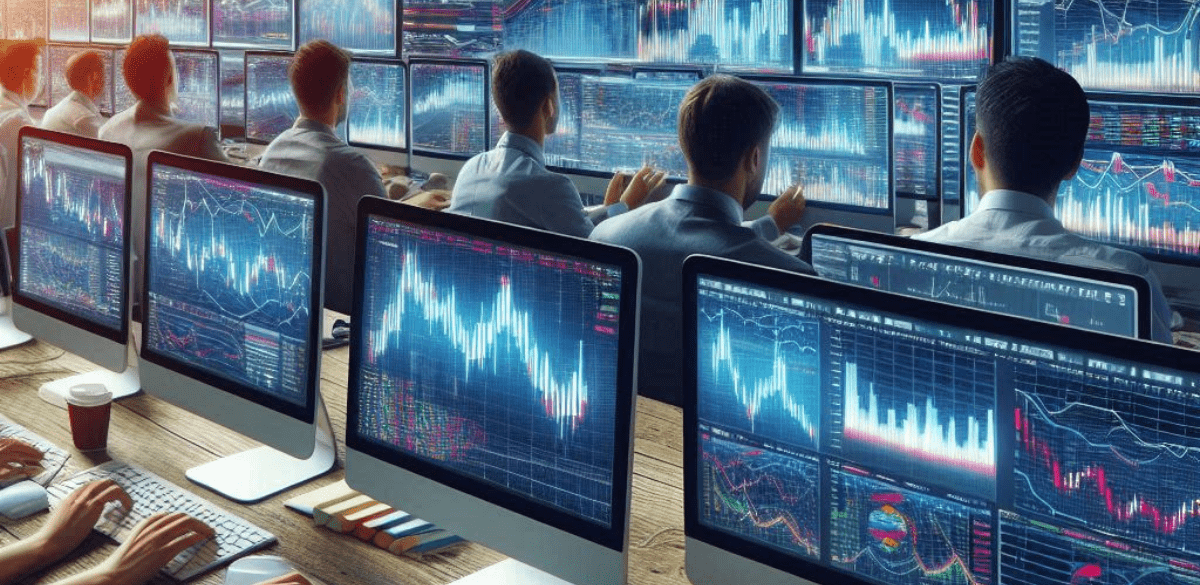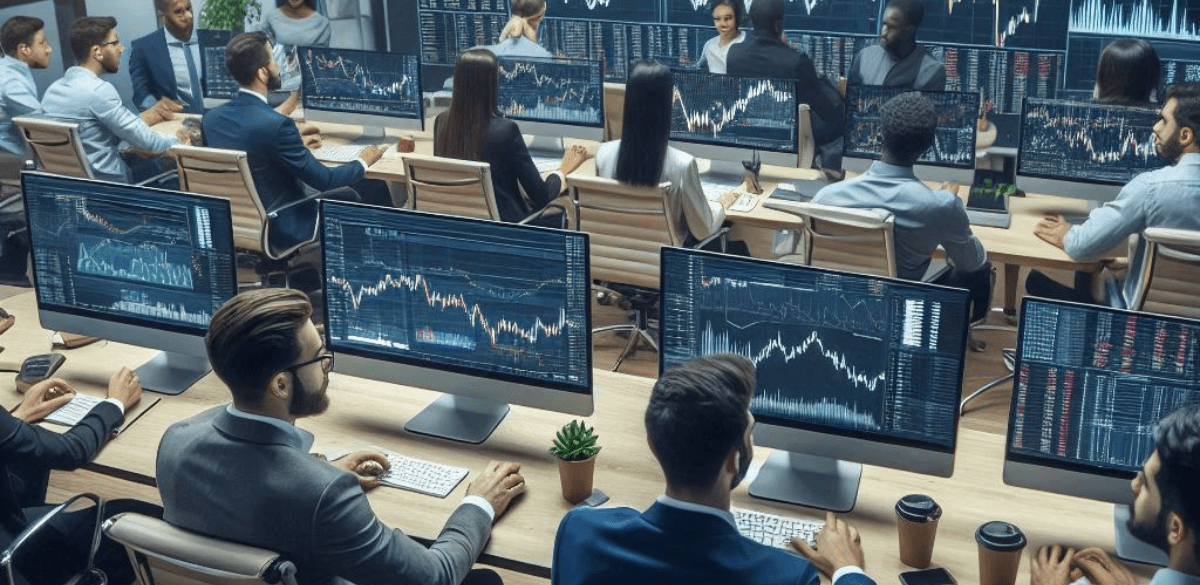Algorithmic trading sounds like a techy buzzword, doesn’t it? But it’s actually a game-changer in the world of finance. Imagine a world where computers, not humans, make the buy and sell decisions in the stock market. Welcome to the realm of algorithmic trading, where technology meets trading to create an exciting, fast-paced financial environment.
What is Algorithmic trading?
Algo trading, or algorithmic trading, uses computer programs to execute trades based on predefined criteria. Think of it as setting up a smart, tireless robot to handle your trades while you sit back and watch the magic happen. These algorithms can analyze market conditions, execute trades at optimal times, and even manage risk—all without the need for human intervention.
How Algorithm Work, What Magic Happened Inside?
Brief History of Algorithmic trading
Algorithmic trading isn’t some newfangled invention. It has roots stretching back to the 1970s when early pioneers began using simple algorithms to handle repetitive trading tasks. Fast forward to today, and algo trading has evolved into a sophisticated, integral part of modern financial markets, thanks to advancements in computing power and data analytics.
How Does Algorithmic Trading Work?

Basic Principles of Algorithms in Trading
At its core, algo trading relies on algorithms—basically, sets of rules or instructions designed to solve specific problems. In trading, these algorithms process vast amounts of data to identify profitable trading opportunities. Once a potential trade is spotted, the algorithm executes it automatically, ensuring speed and precision.
Types of Algorithmic Trading Strategies
High-Frequency Trading (HFT)
High-Frequency Trading is the sprinter of algorithmic trading. It’s all about speed, executing thousands of trades in microseconds. This strategy takes advantage of tiny price discrepancies, which might seem insignificant but add up when done repeatedly.
Statistical Arbitrage
Think of Statistical Arbitrage as a savvy shopper. It involves buying and selling securities based on statistical relationships. If stock A usually goes up when stock B goes down, an algorithm can exploit this relationship for profit.
Market Making
Market Making is like being a middleman. Algorithms places buy and sell orders simultaneously to profit from the spread – the difference between the buying and selling price. It keeps the market liquid and ensures there’s always someone ready to trade.
Trend Following
Ever heard the phrase, “The trend is your friend”? Trend Following strategies look at market trends and make trades based on the direction of these trends. If the market is going up, the algorithm buys. If it’s going down, it sells.
How AI Works? What Magic Happened Inside?

Benefits of Algorithmic trading
Speed and Efficiency
One of the biggest advantages of algo trading is speed. Algorithms can analyze data and execute trades in fractions of a second, far faster than any human could manage. This speed can be the difference between a profitable trade and a missed opportunity.
Reduced Human Error
Humans are prone to mistakes, especially under pressure. Algorithms, on the other hand, follow their instructions to the letter, reducing the risk of costly errors.
Backtesting Capabilities
Before you let your algorithm loose on the live market, you can test it against historical data. This process, known as back testing, helps ensure your strategy is sound and gives you a glimpse of how it might perform in the real world.
Challenges of Algorithmic trading
Market Risks
While algo trading can be incredibly profitable, it’s not without its risks. Market conditions can change rapidly, and an algorithm that performs well in one environment might struggle in another.
Technical Issues
Technical glitches can also pose a problem. A bug in your code or a failure in your internet connection can lead to significant losses if not addressed promptly.
Regulatory Concerns
Algo trading operates within a strict regulatory framework. Compliance with these regulations is crucial, as violations can lead to hefty fines or even a ban from trading.

Getting Started with Algorithmic trading
Necessary Skills and Knowledge
Before diving into algo trading, you’ll need a solid understanding of both trading principles and programming. Familiarity with financial markets and trading strategies is a must, as is proficiency in at least one programming language.
Choosing a Trading Platform
There are numerous trading platforms out there, each with its own strengths and weaknesses. choose the best trading platform that fulfil your requirements and easy to use for you.
Basic Tools and Software
Aside from a trading platform, you’ll need reliable data feeds, back testing software, and robust risk management tools. Many platforms offer these as part of their package, but you may also want to explore third-party options.
What is Machine Learning?: understand in simple way.
Programming Languages for Algorithmic trading
Python
Python is a favorite among algo traders due to its simplicity and powerful libraries, such as Pandas and NumPy. It’s an excellent choice for beginners and experts alike.
R
R is another popular language, especially among those with a statistical background. It’s great for data analysis and visualization, making it a valuable tool for developing and testing trading strategies.
C++
For those needing speed and performance, C++ is the way to go. It’s more complex and harder to learn but offers unmatched execution speed, which can be crucial in high-frequency trading.

Building Your First Algorithm
Setting Up Your Environment
First, choose your preferred programming language and install the necessary development tools. For Python, this might include an IDE like PyCharm or Jupyter Notebook.
Writing a Simple Trading Algorithm
Start with a basic algorithm, such as a moving average crossover strategy. This involves buying when the short-term moving average crosses above the long-term moving average and selling when the opposite occurs.
Testing and Optimization
Once your algorithm is written, test it against historical data to see how it performs. Tweak the parameters and optimize your code to improve its performance.
Back testing Your Strategy
Importance of Backtesting
Backtesting is crucial for validating your strategy. By running your algorithm on historical data, you can gauge its effectiveness and identify potential issues before risking real money.
How to Backtest Effectively
Ensure your data is clean and accurate and use a robust back testing framework. Look for patterns in the results and be wary of overfitting—making your algorithm too tailored to historical data, which can harm its performance in live trading.
Risk Management in Algorithmic trading
Importance of Risk Management
Risk management is vital in algo trading. Without it, even the best algorithm can lead to significant losses.
Common Risk Management Strategies
Some common strategies include setting stop-loss orders to limit losses, using position sizing to control the amount of capital at risk, and diversifying your trades to spread risk across different assets or markets.

Algorithmic trading Strategies
Mean Reversion
Mean reversion strategies assume that prices will revert to their historical mean over time. These algorithms buy when prices are low and sell when they are high, capitalizing on the expected return to the mean.
Momentum Trading
Momentum trading strategies exploit the continuation of existing trends. These algorithms buy assets that are trending upward and sell those trending downward, riding the momentum until it shows signs of reversing.
Statistical Arbitrage
Statistical arbitrage involves trading multiple assets based on their statistical relationships. These strategies often use complex mathematical models to identify mispricing and generate profit.
Future of Algorithmic trading
Emerging Trends
The future of algo trading looks bright, with emerging trends such as AI and machine learning promising to take it to new heights. These technologies can analyze vast amounts of data and identify patterns that human traders might miss, leading to more effective algorithms.
Impact of AI and Machine Learning
AI and machine learning are set to revolutionize algo trading. By enabling algorithms to learn from data and adapt to changing market conditions, these technologies can enhance the speed, accuracy, and profitability of trading strategies.
What is Machine Learning? :understand in simple way.

Ethical Considerations in Algorithmic trading
Market Manipulation Concerns
As powerful as algo trading can be, it also raises ethical concerns. Algorithms that engage in market manipulation—such as spoofing or layering—can disrupt markets and harm other traders.
Transparency and Fairness
Ensuring transparency and fairness in algo trading is crucial. Regulators and market participants must work together to develop and enforce rules that prevent abuse and promote a level playing field.
Conclusion
Algo trading offers a powerful way to automate and enhance your trading. By understanding the basics, choosing the right tools, and developing robust algorithms, you can tap into this exciting field and potentially improve your trading performance. Remember, though, that like any trading strategy, algo trading comes with its risks, so always proceed with caution and prioritize risk management.
FAQs
What is algo trading in simple terms?
Algo trading uses computer programs to execute trades automatically based on predefined rules, allowing for faster and more efficient trading.
Is algo trading legal?
Yes, algo trading is legal, but it must comply with regulatory requirements to ensure fair and transparent market practices.
Can anyone start algo trading?
Anyone with a solid understanding of trading principles and programming skills can start algo trading, but it’s essential to educate yourself and practice thoroughly before trading live.
How much capital is needed for algo trading?
The amount of capital needed can vary widely depending on your trading strategy and the markets you trade. Some strategies may require significant capital, while others can be started with a smaller investment.
What are the best resources to learn algo trading?
Some excellent resources include online courses, books, and trading communities.
